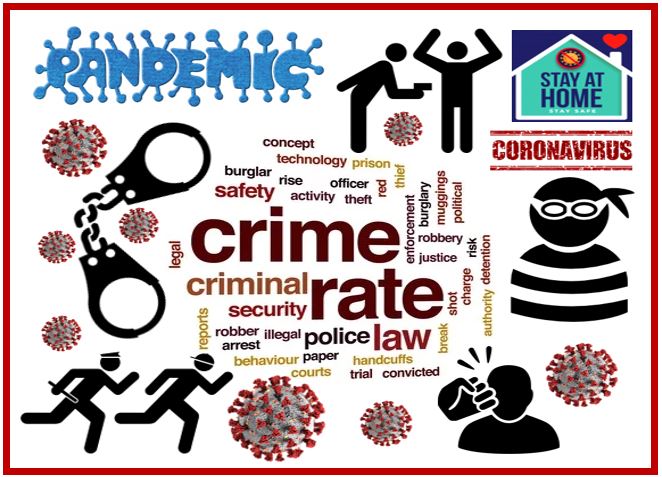The COVID 19 pandemic has significantly impacted crime rates across the US. Most people are marooned at home, with many keenly adhering to social distancing recommendations by health experts. Earlier investigations found that crime rates dipped as cities responded to COVID 19 by implementing social distancing and stay-at-home requirements.
However, recent media reports document violent crimes rising in several cities following police brutality in Minneapolis and other cities.

Social distancing and COVID affecting crime rates
Data for various US cities showed reducing numbers of crime in the early days of the pandemic. As everyone, including criminals and gang members, focused on observing social distance and watching the curve, there were fewer cases of burglary, violence, and murders.
There were massive drops in traffic and person stop, DUIs, and drug offenses. In many jurisdictions, thefts and burglaries decreased helped by the lockdown. Bookings into county jails fell by at least 25% between February and May.
By mid-April, St Louis, for instance, had recorded 45 murders, a considerable decline from 194 murders the same time last year. April data shows that shootings, assaults, and thefts in the city went down by as much as 33% compared to the previous year.
Data for the period between spring and summer shows that assaults with guns declined by 29% in St Louis. Thefts dropped by 18% when compared to the same period in 2019. According to Missouri Highway Patrol data, traffic crashes declined by as much as 90%.
Down south in Atlanta, police lodged only 47 crime reports between January and April. In 2019 the number of processed crime reports in the city had surpassed 150 by April.
Between March 9 and March 27, 226 people were booked into the Cherokee County jail, a significant drop from the 388 arrests made during the same time frame in 2019.
In Oakland, California, crime rates plummeted after governor Gavin Newsom shut down bars, restaurants, movie theaters, gyms, and large gatherings by executive order. The city had had a higher crime rate in 2019, with 27776 robberies recorded up from 25588 in 2018.
Before the stay-at-home order was issued, robbery rates had been up by 6% since the year began. Police data shows that after the implementation of the stay at home order, robberies sharply plummeted.
Robbery with firearms in Oakland reportedly fell to 14 % between January and April. Even though auto burglaries climbed 3 %, overall thefts went down 1 %.
On the other hand, residential burglary dropped by more than 25 % compared to last year’s pace. While generally lawyers recorded a drop in the number of clients seeking legal services, employment lawyers reported a rise in white-collar crime cases, from embezzlement to insurance fraud and internet fraud.
Self-quarantine and the rise of domestic violence

Whereas COVID 19 significantly swept crime off the streets, pundits argue that it simply transferred it back home. In the first quarter of 2020, emergency calls for domestic violence and disturbances increased by 10 % to 30 % based on various police agencies’ data.
A Wall Street Journal report shows that there was a double-digit increase in domestic violence across 36 cities during the pandemic. Police say that they are worried about the rise in domestic violence since people spend more time at home.
With the anxiety of the pandemic and economic uncertainties surrounding the present moment, tempers can flare. Several reports also show an increase in public nuisance complaints, including loud noise from parties.
The domestic violence rate across the US peaked at 22 per 100,000 between spring and summer in 2020. The rate was still slightly lower than that of 209. Reports from 13 cities show that the rise in domestic violence in 2020 has not been greater than in 2018.
The complexities of economic disruption, racial tension and the rising crime in the states
Following May 25—the killing of George Floyd in Minneapolis—murder and crime rates have risen in many of America’s cities. Economists, psychologists, and other experts link what is happening right now to the COVID 19 pandemic. It is not just police brutality—when things such as health, wealth, and education, are factored, black people are twice more likely to die of COVID-19 than whites, hence the racial unrest.
So while lockdown and social distancing kept crime rates statistically low in major cities across the US, violence, gun assault, and homicides began to increase in late May. Currently, murders have soared by double-digit percentages from New York to Philadelphia to Chicago, Florida, others.
Late July, data analysts found that murder rates were up 23 % compared to 2019. Homicides had risen by 24%, to 3,512 murders across US cities. Austin, Texas, has recorded the sharpest increase in homicide rates at 50 % higher than 2019.
There is a complex mix of reasons behind the recent rise in crime rates in the US amid the COVID 19 pandemic. Experts say that stresses from unemployment and the fact that young people are idle and out of school may have led to increased murder rates as the society comes under pressure in diverse ways.
COVID 19 and its consequences, such as general financial hardships and the early release of prisoners, have largely contributed to the spike in crime rates in US cities.
Interesting related article: “What does White Collar mean?“

